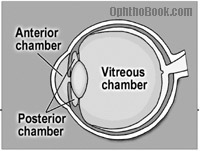How many chambers are there in the eye?
There are actually three chambers in the eye. The anterior chamber behind the cornea. The posterior chamber sits behind the iris and in front of the lens, while the vitreous chamber fills the majority of the eye behind the iris.

good illustration thanks.
This is incorrect. The posterior chamber extends from the lens to the retina. The anterior chamber is between the iris and the cornea.
YOU are wrong christina
The posterior chamber should not be confused with vitreous chamber. The posterior chamber is a narrow chink behind the peripheral part of the iris of the lens, and in front of the suspensory ligament of the lens and the ciliary processes. The Posterior Chamber consists of small space directly posterior to the Iris but anterior to the lens
I THINK WE SHOULD RATHER CLASSIFY IT AS ANTERIOR SEGMENT-MADE OF ANTERIOR CHAMBER AND POSTERIOR CHAMBER AND POSTERIOR SEGMENT-MADE OF AS VITREOUS/CHAMBER.
than you doctore.
thank you doctor for this clearification,before, i was made to understand that there are two chambers and that the vitreous is not a chamber but a body.thanks again.Edwine.
Good job
If you were to present on glaucoma to nursing or medical students, what simple realia would you use in your class
I would use powerpoint.
i like this illustration
thank you
I’m unclear about the posterior limit of the posterior chamber…there seems to be some ambiguity in the different texts.
Where is the posterior wall of the posterior chamber of the eye?
Wolff’s Anatomy of the Eye and Orbit (8th Ed.) as well as “Clinical Ocular Anatomy and Physiology” (Bergmanson, 21 Ed.) states that the poster chamber of the eye ends at the anterior surface of the vitreous. However, various other texts are either unclear (“Clinical Anatomy and Physiology of the Visual System”) or directly contradict this view, stating that the anterior surface of the lens represents the posterior surface of the posterior chamber (i.e. the lens itself is not contained in the posterior chamber) (Clinical Anatomy of the Eye by Snell, http://www.emedicinehealth.com/anatomy_of_the_eye/page10_em.htm, etc.).
Can someone help?
omg is this right or not?